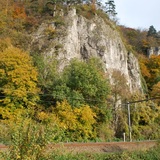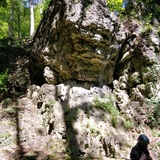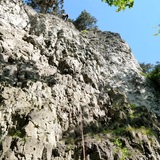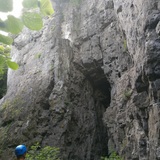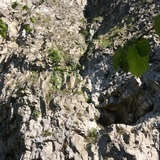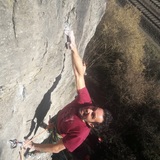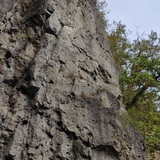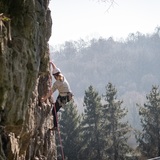The cliffs of Beez are part of the longest chain of cliffs of the Meuse valley also known as the cliffs of Marche-les-Dames. Starting with these cliffs just in front of the marina, they are continuing to the east with the numerous cliffs of King Albert 1st (not authorized for climbing due to the proximity of the road) with the memorial for King Albert 1st who died accidentely during a solo ascent on 17 february 1934. Then the cliffs inside the military Training Center for Commandos, only autorized during the week-ends exclusively for members of Club Alpin Belge, Klim en Bergsport Federatie and Union Belge de Spéleo. You must show your ID card and the member card together. Then the cliffs behind the brasserie "La Féraugière" and in front of the railstation (these cliffs are also not authorized for climbing). Then the chain was in the past continuing even further, but now the huges quarries of Marche-les-Dames (Lhoist and Sagrex) are extracting the dolomite of very good quality for different uses.
The climbing occurs on a dolomite limestone that is characterized by verticality, overhangs and holes (some big and some small), usually quite physical climbing. All routes are bolted with usually some distance between the bolts as it was the use in the 80-90ies.
Climbing on these cliffs started in the years 1930 when the members of the Club Alpin Belge were looking for training before going in the Alps and the Dolomites. At that time there was no road under the clifs, only a path but also the railway that exists since 1850. After WWII and the location of the Training Center for Commandos, the climbing was developped on most of the cliffs of Marche-les-Dames, but with some exception (Fanette), most cliffs of Beez were covered with ivy. A group of local climbers began the cleaning of the cliffs and equipment of the routes in the beginning of the 80ies.They formed an association "GASE" (Groupe Aménagement des Sites d'Escalade) and made the first topo-guide dedicated for "Marche-les-Dames", the profits from the sale were used to buy the equipment. The Club Alpin Belge took over the management of the cliffs end of the 90ies with a convention with the owners (Région Wallonne et Ville de Namur) and the mandatory permits as the cliffs were also becoming part of Natura 2000 network.


The area is access sensitive!
As for all climbing sites in Belgium, you must be member of the climbing federation that manages the site (here the Club Alpin Belge). The CAB has reciprocity agreement with the other belgian federations (KBF, UBS) and the NKBV (Netherlands). The active members of other climbing federations of UIAA are also allowed for climbing if they also have an insurance for civilian liability covering climbing activities.
Parking : the cars can park on a big parking place between the railway and the marine. There can be a lot of cars during sunnies week-ends so park closely to each others and perpendicular to the road.
⛔️🛤
IT IS STRICTLY FORBIDDEN TO CROSS THE RAILWAY.
Just walk along the road and take the bridge over the railway. A good path starts from the bridge and lead to most of the cliffs, except the "Caribou". The main path is continuing behind the "Centenaire" and goes up in a valley to the Marche-les-Dames forest. At the beginning of the valley you have the "Jokari".To go to "Ecrin, Jonction and Cellier), you have to continue along the railway for about 150 m. For the "Caribou", from the bridge, continue about 75 m, go over the road protection rail and follow a small and steep path to the right. See map in the "photo" area.
Coming down. For most of the routes, you can lower off or abseil. If you want to exit to the summit, there is a small path almost following the wooded crest and joining the main path in the valley just after the "Jokari". All the ravines between the cliffs are impassable and strictly forbidden (Natura 2000 sensitive protected area).
